Around the World
May/June 2023
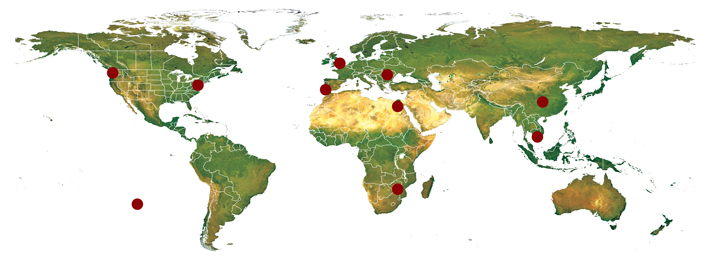

-
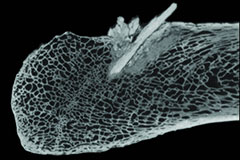 WASHINGTON: Researchers determined that a mastodon living in the Pacific Northwest 13,900 years ago was wounded when it was struck by a spear. The elephant-like animal’s remains were first discovered 45 years ago at the Manis Mastodon site on the Olympic Peninsula. Recent CT scanning and 3-D software analysis revealed that tiny bone fragments embedded in its rib were pieces of a projectile fashioned from the leg bone of another mastodon. This represents the oldest known bone spearpoint in the Americas and the earliest evidence of mastodon hunting.
WASHINGTON: Researchers determined that a mastodon living in the Pacific Northwest 13,900 years ago was wounded when it was struck by a spear. The elephant-like animal’s remains were first discovered 45 years ago at the Manis Mastodon site on the Olympic Peninsula. Recent CT scanning and 3-D software analysis revealed that tiny bone fragments embedded in its rib were pieces of a projectile fashioned from the leg bone of another mastodon. This represents the oldest known bone spearpoint in the Americas and the earliest evidence of mastodon hunting. -
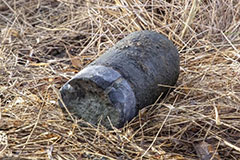 PENNSYLVANIA: A U.S. Army ordnance disposal team was summoned to Gettysburg when a 160-year-old live artillery shell was uncovered during archaeological work. The 7-inch-long unexploded round was found 2 feet below the surface near a rocky outcrop known as Little Round Top. During the Civil War’s bloody Battle of Gettysburg, Little Round Top was held by Union troops. It witnessed intense fighting during a Confederate assault on July 2, 1863, that resulted in as many as 1,700 casualties.
PENNSYLVANIA: A U.S. Army ordnance disposal team was summoned to Gettysburg when a 160-year-old live artillery shell was uncovered during archaeological work. The 7-inch-long unexploded round was found 2 feet below the surface near a rocky outcrop known as Little Round Top. During the Civil War’s bloody Battle of Gettysburg, Little Round Top was held by Union troops. It witnessed intense fighting during a Confederate assault on July 2, 1863, that resulted in as many as 1,700 casualties. -
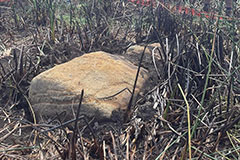 CHILE: A new moai was found at the bottom of a dry lake bed in the Rano Raraku volcanic crater on Easter Island. The iconic sculptures were carved between 1,000 and 500 years ago and represent the ancestors of the island’s Rapanui people. Measuring just 5 feet tall, the new figure is relatively small compared to others on the island, which average 13 feet in height and weigh around 14 tons each. The majority of Easter Island’s 1,000 moai were carved out of Rano Raraku’s soft volcanic tuff.
CHILE: A new moai was found at the bottom of a dry lake bed in the Rano Raraku volcanic crater on Easter Island. The iconic sculptures were carved between 1,000 and 500 years ago and represent the ancestors of the island’s Rapanui people. Measuring just 5 feet tall, the new figure is relatively small compared to others on the island, which average 13 feet in height and weigh around 14 tons each. The majority of Easter Island’s 1,000 moai were carved out of Rano Raraku’s soft volcanic tuff. -
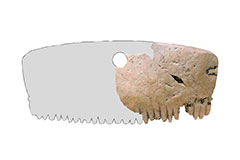 ENGLAND: When an Iron Age (ca. 750 B.C.–A.D. 43) bone comb was found during road construction in Bar Hill near Cambridge, it was considered a rare discovery. Closer inspection, however, revealed just how unusual the object is. Researchers determined that the comb was made from a piece of human skull. It showed no signs of use, but a hole had been drilled into its middle, suggesting that it was likely worn around the neck as an amulet.
ENGLAND: When an Iron Age (ca. 750 B.C.–A.D. 43) bone comb was found during road construction in Bar Hill near Cambridge, it was considered a rare discovery. Closer inspection, however, revealed just how unusual the object is. Researchers determined that the comb was made from a piece of human skull. It showed no signs of use, but a hole had been drilled into its middle, suggesting that it was likely worn around the neck as an amulet. -
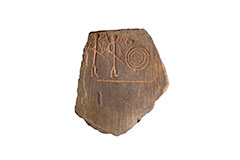 PORTUGAL: Steel is considered by many one of the great Industrial Age inventions, but it turns out some inhabitants of Iberia were capable of forging tempered steel tools 2,900 years ago. Metallographic analysis of a chisel from Rocha do Vigio determined that it is made of carbon-rich steel. This durable material was needed to carve stone stelas featuring complex anthropomorphic and geometric motifs, because the local silicated quartz sandstone was much too hard for stone, bronze, or iron chisels.
PORTUGAL: Steel is considered by many one of the great Industrial Age inventions, but it turns out some inhabitants of Iberia were capable of forging tempered steel tools 2,900 years ago. Metallographic analysis of a chisel from Rocha do Vigio determined that it is made of carbon-rich steel. This durable material was needed to carve stone stelas featuring complex anthropomorphic and geometric motifs, because the local silicated quartz sandstone was much too hard for stone, bronze, or iron chisels. -
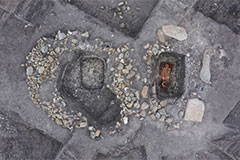 BULGARIA: Horses were first domesticated around 5,500 years ago on the Eurasian steppe and were bred for their milk. Just a few centuries later, researchers have discovered, the people of the Yamnaya culture became the first to ride them. Archaeologists examined the skeletal remains of Yamnaya burials across Romania, Bulgaria, and Hungary. They noticed considerable musculoskeletal damage to the femurs, hips, and vertebrae of some individuals, which they believe was caused by the trauma of frequent horse riding.
BULGARIA: Horses were first domesticated around 5,500 years ago on the Eurasian steppe and were bred for their milk. Just a few centuries later, researchers have discovered, the people of the Yamnaya culture became the first to ride them. Archaeologists examined the skeletal remains of Yamnaya burials across Romania, Bulgaria, and Hungary. They noticed considerable musculoskeletal damage to the femurs, hips, and vertebrae of some individuals, which they believe was caused by the trauma of frequent horse riding. -
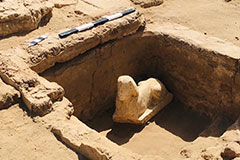 EGYPT: Excavators digging near the Roman-era Temple of Horus within the Dendera Temple complex uncovered a subterranean chamber that contained a small limestone sphinx. The sculpture bears an unusual countenance that includes a slight smirk and dimples, features not commonly found on sphinx statues. Archaeologists believe that it may represent the emperor Claudius (reigned A.D. 41–54), ruler of the Roman Empire, which included Egypt.
EGYPT: Excavators digging near the Roman-era Temple of Horus within the Dendera Temple complex uncovered a subterranean chamber that contained a small limestone sphinx. The sculpture bears an unusual countenance that includes a slight smirk and dimples, features not commonly found on sphinx statues. Archaeologists believe that it may represent the emperor Claudius (reigned A.D. 41–54), ruler of the Roman Empire, which included Egypt. -
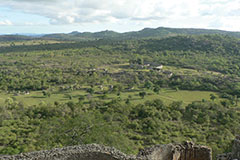 ZIMBABWE: One mystery surrounding the earliest city in southern Africa appears to have been solved. Great Zimbabwe, from which the modern country takes its name, flourished from the 12th to 15th century A.D. as the capital of the Kingdom of Zimbabwe. Given the area’s susceptibility to drought, scholars have wondered how the city’s inhabitants were able to obtain enough water to sustain themselves. A new survey uncovered a series of depressions outside the city called dhaka pits that were used to store water in the dry season as part of an ingenious water management system.
ZIMBABWE: One mystery surrounding the earliest city in southern Africa appears to have been solved. Great Zimbabwe, from which the modern country takes its name, flourished from the 12th to 15th century A.D. as the capital of the Kingdom of Zimbabwe. Given the area’s susceptibility to drought, scholars have wondered how the city’s inhabitants were able to obtain enough water to sustain themselves. A new survey uncovered a series of depressions outside the city called dhaka pits that were used to store water in the dry season as part of an ingenious water management system. -
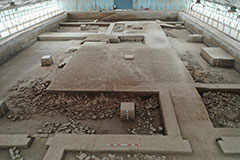 CHINA: The ruins of the sprawling ancient palace at Yueyang in the city of Xi’an attest to the lavish life its royal residents led when the city was an important capital during the late Qin and early Han Dynasties, between 2,400 and 2,200 years ago. The residents also seem to have had an extravagant luxury item: a flushing toilet, among the oldest ever discovered. The indoor lavatory was connected to the palace’s exterior with a pipe so the toilet could be flushed by servants pouring water through it.
CHINA: The ruins of the sprawling ancient palace at Yueyang in the city of Xi’an attest to the lavish life its royal residents led when the city was an important capital during the late Qin and early Han Dynasties, between 2,400 and 2,200 years ago. The residents also seem to have had an extravagant luxury item: a flushing toilet, among the oldest ever discovered. The indoor lavatory was connected to the palace’s exterior with a pipe so the toilet could be flushed by servants pouring water through it. -
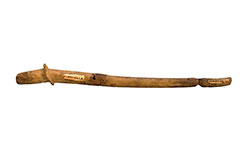 VIETNAM: A 13-inch-long piece of antler found 30 years ago at the site of Go O Chua in the Mekong Delta may be part of the oldest stringed instrument discovered in Southeast Asia. The 2,000-year-old antler, either from a sambar deer or an Indian hog deer, was originally thought to be just a well-preserved ancient organic object. However, recent analysis revealed an unusual round hole at one end. The small aperture was made deliberately and likely once held a peg used to tune the single string of what is known as a chordophone instrument.
VIETNAM: A 13-inch-long piece of antler found 30 years ago at the site of Go O Chua in the Mekong Delta may be part of the oldest stringed instrument discovered in Southeast Asia. The 2,000-year-old antler, either from a sambar deer or an Indian hog deer, was originally thought to be just a well-preserved ancient organic object. However, recent analysis revealed an unusual round hole at one end. The small aperture was made deliberately and likely once held a peg used to tune the single string of what is known as a chordophone instrument.
Advertisement
IN THIS ISSUE
Advertisement

Recent Issues
-
 May/June 2024
May/June 2024
-
 March/April 2024
March/April 2024
-
 January/February 2024
January/February 2024
-
 November/December 2023
November/December 2023
-
 September/October 2023
September/October 2023
-
 July/August 2023
July/August 2023
-
 May/June 2023
May/June 2023
-
 March/April 2023
March/April 2023
-
 January/February 2023
January/February 2023
-
 November/December 2022
November/December 2022
-
 September/October 2022
September/October 2022
-
 July/August 2022
July/August 2022
-
 May/June 2022
May/June 2022
-
 March/April 2022
March/April 2022
-
 January/February 2022
January/February 2022
-
 November/December 2021
November/December 2021
-
 September/October 2021
September/October 2021
-
 July/August 2021
July/August 2021
-
 May/June 2021
May/June 2021
-
 March/April 2021
March/April 2021
-
 January/February 2021
January/February 2021
-
 November/December 2020
November/December 2020
-
 September/October 2020
September/October 2020
-
 July/August 2020
July/August 2020
-
 May/June 2020
May/June 2020
-
 March/April 2020
March/April 2020
-
 January/February 2020
January/February 2020
-
 November/December 2019
November/December 2019
-
 September/October 2019
September/October 2019
-
 July/August 2019
July/August 2019
-
 May/June 2019
May/June 2019
-
 March/April 2019
March/April 2019
-
 January/February 2019
January/February 2019
-
 November/December 2018
November/December 2018
-
 September/October 2018
September/October 2018
-
 July/August 2018
July/August 2018
-
 May/June 2018
May/June 2018
-
 March/April 2018
March/April 2018
-
 January/February 2018
January/February 2018
-
 November/December 2017
November/December 2017
-
 September/October 2017
September/October 2017
-
 July/August 2017
July/August 2017
-
 May/June 2017
May/June 2017
-
 March/April 2017
March/April 2017
-
 January/February 2017
January/February 2017
-
 November/December 2016
November/December 2016
-
 September/October 2016
September/October 2016
-
 July/August 2016
July/August 2016
-
 May/June 2016
May/June 2016
-
 March/April 2016
March/April 2016
-
 January/February 2016
January/February 2016
-
 November/December 2015
November/December 2015
-
 September/October 2015
September/October 2015
-
 July/August 2015
July/August 2015
-
 May/June 2015
May/June 2015
-
 March/April 2015
March/April 2015
-
 January/February 2015
January/February 2015
-
 November/December 2014
November/December 2014
-
 September/October 2014
September/October 2014
-
 July/August 2014
July/August 2014
-
 May/June 2014
May/June 2014
-
 March/April 2014
March/April 2014
-
 January/February 2014
January/February 2014
-
 November/December 2013
November/December 2013
-
 September/October 2013
September/October 2013
-
 July/August 2013
July/August 2013
-
 May/June 2013
May/June 2013
-
 March/April 2013
March/April 2013
-
 January/February 2013
January/February 2013
-
 November/December 2012
November/December 2012
-
 Sep/Oct 2012
Sep/Oct 2012
-
 September/October 2012
September/October 2012
-
 July/August 2012
July/August 2012
-
 May/June 2012
May/June 2012
-
 March/April 2012
March/April 2012
-
 January/February 2012
January/February 2012
-
 November/December 2011
November/December 2011
-
 September/October 2011
September/October 2011
-
 July/August 2011
July/August 2011
-
 May/June 2011
May/June 2011
-
 March/April 2011
March/April 2011
-
 January/February 2011
January/February 2011
Advertisement






